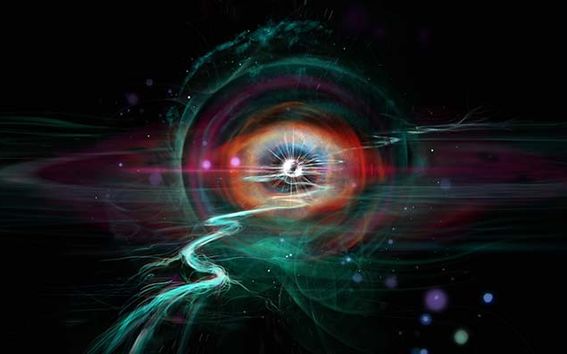Destruction of a quantum monopole observed

The new study provided a surprise: the quantum monopole decays into another analogue of the magnetic monopole. The obtained fundamental understanding of monopole dynamics may help in the future to build even closer analogues of the magnetic monopoles.
Unlike usual magnets, magnetic monopoles are elementary particles that have only a south or a north magnetic pole, but not both. They have been theoretically predicted to exist, but no convincing experimental observations have been reported. Thus physicists are busy looking for analogue objects.
– In 2014, we experimentally realized a Dirac monopole, that is, Paul Dirac’s 80-year-old theory where he originally considered charged quantum particles interacting with a magnetic monopole, says Professor David Hall from Amherst College, USA.
– And in 2015, we created real quantum monopoles, adds Dr. Mikko Möttönen from Aalto University.
Whereas the Dirac monopole experiment simulates the motion of a charged particle in the vicinity of a monopolar magnetic field, the quantum monopole has a point-like structure in its own field resembling that of the magnetic monopole particle itself.
Experimental side image of the quantum monopole on the left. After 0.2 seconds, the quantum monopole has decayed into the Dirac monopole shown on the right. The different colors represent the direction of the internal magnetic state of the atoms and the brightness corresponds to particle density. See instructions below to access the full-resolution image. Credit: Tuomas Ollikainen.
From one quantum monopole to another in less than a second
Now the monopole collaboration led by David Hall and Mikko Möttönen has produced an observation of how one of these unique magnetic monopole analogues spontaneously turns into another in less than a second.
– Sounds easy but we actually had to improve the apparatus to make it happen, says Mr. Tuomas Ollikainen who is the first author of the new work.
The scientists start with an extremely dilute gas of rubidium atoms chilled near absolute zero, at which temperature it forms a Bose–Einstein condensate. Subsequently, they prepare the system in a non-magnetized state and ramp an external magnetic-field zero point into the condensate thus creating an isolated quantum monopole. Then they hold the zero point still and wait for the system to gradually magnetize along the spatially varying magnetic field. The resulting destruction of the quantum monopole gives birth to a Dirac monopole.
– I was jumping in the air when I saw for the first time that we get a Dirac monopole from the decay. This discovery nicely ties together the monopoles we have been producing over the years, says Dr. Möttönen.
Beyond Nobel physics
The quantum monopole is a so-called topological point defect, that is, a single point in space surrounded by a structure in the non-magnetized state of the condensate that cannot be removed by continuous reshaping. Such structures are related to the 2016 Nobel Prize in Physics which was awarded in part for discoveries of topological phase transitions involving quantum whirlpools, or vortices.
– Vortex lines have been studied experimentally in superfluids for decades; monopoles, on the other hand, have been studied experimentally for just a few years, says Prof. Hall.
Although its topology protects the quantum monopole, it can decay since the whole phase of matter changes from non-magnetized to magnetized.
– No matter how robust an ice sculpture you make, it all flows down the drain when the ice melts, says Mr. Ollikainen.
– For the first time, we observed spontaneously appearing Dirac monopoles and the related vortex lines, says Dr. Möttönen.
View towards the main experimental chamber of the apparatus, showing the magnetic field coils and optical components required to create the superfluid containing the quantum monopole. See instruction above to access the full-resolution image. Credit: Marcus DeMaio/Amherst College April 2015.
The research article:
T. Ollikainen, K. Tiurev, A. Blinova, W. Lee, D. S. Hall, and M. Möttönen: Experimental realization of a Dirac monopole through the decay of an isolated monopole. Physical Review X 7, DOI: 10.1103/PhysRevX.7.021023
Free link: https://journals.aps.org/prx/abstract/10.1103/PhysRevX.7.021023
This research article should be credited as the source of information.
This material is based upon work supported the National Science Foundation (Grant No. PHY-1519174), by the Academy of Finland through its Centres of Excellence Program (Grants No. 251748 and No. 284621) and Grant No. 308071, by the European Research Council under Consolidator Grant No. 681311 (QUESS), by the Magnus Ehrnrooth Foundation, by the Education Network in Condensed Matter and Materials Physics, and by the KAUTE Foundation through its Researchers Abroad program.
Related video on the creation of a quantum monopole, 2015 (not on the decay into a Dirac monopole)
An article on previous purely theoretical studies on the phenomenon by the author
Contact details:
David S. Hall, Professor
Amherst College
tel. +1 413 542 2072 (Time zone: GMT -5)
dshall@amherst.edu
http://www3.amherst.edu/~halllab/
Mikko Möttönen, Docent, Doctor of Science
Aalto University
tel. +358 50 594 0950 (Time zone: GMT +2)
mikko.mottonen@aalto.fi
http://physics.aalto.fi/en/groups/qcd/
Tuomas Ollikainen, Master of Science
Aalto University
tel. +358 50 435 4066 (Time zone: GMT +2)
tuomas.ollikainen@aalto.fi
http://physics.aalto.fi/en/groups/qcd/
Read more news

Your voice gives away valuable personal information, so how do you keep that data safe?
With speech technologies becoming increasingly common, researchers want to make sure we don’t give away more information than we mean to.
Aalto in 2025: Quantum leaps, creative breakthroughs and solutions for a better life
Growth, technology and industrial renewal; human-centred solutions; health and everyday wellbeing; and enjoyable daily life and thriving communities.
Research Council of Finland establishes a Center of Excellence in Quantum Materials
The Centre, called QMAT, creates new materials to power the quantum technology of coming decades.






